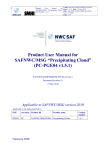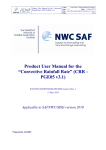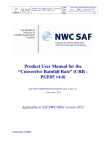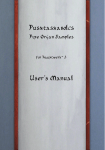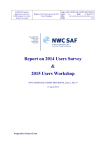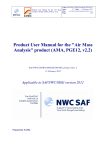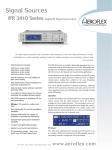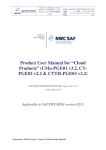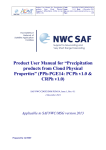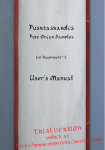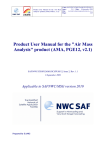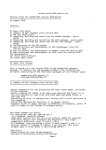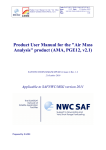Download Product User Manual for SAFNWC/MSG “Precipitating Cloud” (PC
Transcript
Code:SAF/NWC/CDOP2/SMHI/SCI/PUM/4 Product User Manual for Issue: 1.5.4 Date: 15 July 2013 SAFNWC/MSG “Precipitating Cloud” File: SAF-NWC-CDOP2-SMHI-SCI-PUM(PC-PGE04 v1.5) 4_v1.5.4 Page: 1/18 Product User Manual for SAFNWC/MSG “Precipitating Cloud” (PC-PGE04 v1.5) SAF/NWC/CDOP2/SMHI/SCI/PUM/4, Issue 1, Document Revision 5.4 15 July 2013 Applicable to SAFNWC/MSG version 2013 Applicable to the following PGE:s: PGE Acronym Product ID PGE04 PC Prepared by SMHI Product name SAFNWC/MSG/PGE04 Precipitating Clouds Version number 1.5 Code:SAF/NWC/CDOP2/SMHI/SCI/PUM/4 Product User Manual for Issue: 1.5.4 Date: 15 July 2013 SAFNWC/MSG “Precipitating Cloud” File: SAF-NWC-CDOP2-SMHI-SCI-PUM(PC-PGE04 v1.5) 4_v1.5.4 Page: 2/18 REPORT SIGNATURE TABLE Function Prepared by Name SMHI, Anke Thoss Signature Date 15 February 2012 Reviewed by Pilar Fernandez Authorised by AEMET, NWCSAF Manager 15 May 2013 Code:SAF/NWC/CDOP2/SMHI/SCI/PUM/4 Product User Manual for Issue: 1.5.4 Date: 15 July 2013 SAFNWC/MSG “Precipitating Cloud” File: SAF-NWC-CDOP2-SMHI-SCI-PUM(PC-PGE04 v1.5) 4_v1.5.4 Page: 3/18 DOCUMENT CHANGE RECORD Version Pages CHANGE(S) 23 January 2009 2 March 2009 16 17 1.5.1d 19 April 2010 22 1.5.1 1.5.2d 25 May 2010 11 February 2011 18 18 1.5.3.d 11 October 2011 18 1.5.3 1.5.4 15 February 2012 15 July 2013 18 18 New Document for v2009 Changes after DRI-2009: -Corrected erroneous references and add short reference names -Acronym list updated -Erroneous reference to PPS in chapter 1.3 deleted -Applicable documents: dates and codes updated -clarified reference to last scientific update in section 1.7 . – no scientific updates. Adapted date, issue and revision to v. 2010 - Included reference to VS report nov. 2009 Added the full NWCSAF logotype on first page. No scientific updates. Adapted date, issue and rev. to v2011. No scientific updates. Adapted date, issue and rev. to v2012. Updated references No scientific updates. Adapted date, issue and rev. to v2013 1.5d 1.5 Date Code:SAF/NWC/CDOP2/SMHI/SCI/PUM/4 Product User Manual for Issue: 1.5.4 Date: 15 July 2013 SAFNWC/MSG “Precipitating Cloud” File: SAF-NWC-CDOP2-SMHI-SCI-PUM(PC-PGE04 v1.5) 4_v1.5.4 Page: 4/18 Table of contents 1. INTRODUCTION.................................................................................................................................. 6 1.1 SCOPE OF THE DOCUMENT ................................................................................................................ 6 1.2 SCOPE OF OTHER DOCUMENTS .......................................................................................................... 6 1.3 WHO SHOULD READ THIS MANUAL ................................................................................................... 6 1.4 SOFTWARE VERSION IDENTIFICATION ............................................................................................... 6 1.5 DEFINITIONS, ACRONYMS AND ABBREVIATIONS................................................................................ 6 1.6 REFERENCES .................................................................................................................................... 7 1.6.1 Applicable Documents................................................................................................................. 7 1.6.2 Reference Documents.................................................................................................................. 7 1.7 SCIENTIFIC UPDATES SINCE MSG VERSION 2011 .............................................................................. 8 2. DESCRIPTION OF THE PRODUCT................................................................................................... 9 2.1 GOAL OF THE PC PRODUCT ............................................................................................................... 9 2.2 OUTLINE OF THE PRECIPITATING CLOUD ALGORITHM ......................................................................... 9 2.2.1 General algorithm design............................................................................................................ 9 2.2.2 Data sources for Precipitationg Clouds ....................................................................................... 9 2.2.3 Graphical overview of the Precipitating Clouds product (PGE04) ............................................. 10 2.2.4 Description of the output ........................................................................................................... 11 2.2.5 Statistics file.............................................................................................................................. 12 3. IMPLEMENTATION OF THE PRODUCT ....................................................................................... 13 4. INPUTS AND CONFIGURABLE PARAMETERS............................................................................ 14 4.1 4.2 5. LIST OF INPUTS............................................................................................................................... 14 CONFIGURABLE PARAMETERS ......................................................................................................... 14 VALIDATION ..................................................................................................................................... 15 5.1 SUMMARY OF VALIDATION RESULTS ............................................................................................... 15 6. KNOWN PROBLEM AREAS AND LIMITATIONS......................................................................... 17 7. EXAMPLE OF PRODUCT VISUALISATION .................................................................................. 18 Code:SAF/NWC/CDOP2/SMHI/SCI/PUM/4 Product User Manual for Issue: 1.5.4 Date: 15 July 2013 SAFNWC/MSG “Precipitating Cloud” File: SAF-NWC-CDOP2-SMHI-SCI-PUM(PC-PGE04 v1.5) 4_v1.5.4 Page: 5/18 List of Tables and Figures Table 1: List of Applicable Documents.............................................................................................7 Table 2: List of Referenced Documents ............................................................................................7 Table 3: Quality flags of PGE04 .....................................................................................................12 Figure 1: schematic overview over the Precipitating Clouds product 10 Figure 2: 200901241200 precipitating clouds product over MSG-N, configured for day algorithm. Dark green hues present precipitation likelihood classes 10%-20%,light green 30%, yellow40% and orange/red hues 50% and higher. 12 Figure 3: Likelihood of rain from PC product versus observed rain frequency. Cloud type dependent tuning on French gauge data.Left: independent validation against Hungarian gauge data 2004, right: performance on dependent French gauge data set 2004. verified against 30 min averages in gauge data. Blue:high and very high clouds, red: medium level clouds,green: thick cirrus,cyan: cirrus over lower clouds. 15 Figure 4: Likelihood of rain versus observed rain frequency. Same as Figure 3 but for night time. 16 Figure 5: Example of the precipitating clouds product with a change from day to night algorithm diagonally over the British isles (northward night algorithm, south day algorithm).Please note typical features: precipitation area more spread out for night time algorithm, less detailed features and no high precipitation likelihood. At high satellite viewing angles the product becomes unreliable as seen by high precipitation likelihood at the rim of the Meteosat disk.(do not use for satellite viewing angles exceeding 60 degrees). 18 Code:SAF/NWC/CDOP2/SMHI/SCI/PUM/4 Product User Manual for Issue: 1.5.4 Date: 15 July 2013 SAFNWC/MSG “Precipitating Cloud” File: SAF-NWC-CDOP2-SMHI-SCI-PUM(PC-PGE04 v1.5) 4_v1.5.4 Page: 6/18 1. INTRODUCTION The Eumetsat “Satellite Application Facilities” (SAF) are dedicated centres of excellence for processing satellite data, and form an integral part of the distributed EUMETSAT Application Ground Segment ( http://www.eumetsat.int ). This documentation is provided by the SAF on Support to Nowcasting and Very Short Range Forecasting, SAFNWC. The main objective of SAFNWC is to provide, further develop and maintain software packages to be used for Nowcasting applications of operational meteorological satellite data by National Meteorological Services. More information can be found at the SAFNWC webpage, http://www.nwcsaf.org . This document is applicable to the SAFNWC processing package for Meteosat satellites meteorological satellites, SAFNWC/MSG. 1.1 SCOPE OF THE DOCUMENT This document is the Product User Manual for the SAFNWC MSG Precipitating Clouds product. The document describes how to use the product after installation. It is meant to support the interpretation as well as describe the possibilities and limitations. 1.2 SCOPE OF OTHER DOCUMENTS The algorithm used in the Precipitating Clouds Product is described in more detail in the corresponding Algorithm Theoretical Basis document [AD. 6]. Validation of the algorithm is detailed in the Validation report for Precipitating Clouds [AD. 1]. Instructions how to install, configure and execute the software are given in the Software User Manual for NWCSAF MSG Package [AD. 2]. The Interface Control Documents [AD. 3] (for the External and Internal Interfaces of the SAFNWC/MSG) and [AD. 4](MSG Output Product Format Definition) detail the input and output data format for the SAFNWC/MSG software. 1.3 WHO SHOULD READ THIS MANUAL This document is intended for the end-user, i.e. the forecaster. For the person in charge of building and installing the MSG software package, thus the sys-admin we refer to the Software User Manual ([AD. 2]), which will of course also be relevant for the science-admin. For the person interested in the algorithms in detail we refer to the Algorithm theoretical Basis Document[AD. 6]. 1.4 SOFTWARE VERSION IDENTIFICATION This document describes the algorithms implemented in the PGE04 version v1.5 of the 2012 SAFNWC/MSG software package delivery. 1.5 DEFINITIONS, ACRONYMS AND ABBREVIATIONS Acronym CDOP Explanation Continuous Development and Operational Phase Acronym CM CT Explanation Cloud Mask (also PGE01) Cloud Type (also PGE02) Code:SAF/NWC/CDOP2/SMHI/SCI/PUM/4 Product User Manual for Issue: 1.5.4 Date: 15 July 2013 SAFNWC/MSG “Precipitating Cloud” File: SAF-NWC-CDOP2-SMHI-SCI-PUM(PC-PGE04 v1.5) 4_v1.5.4 Page: 7/18 Acronym CTTH EUMETSAT FAR FOV HDF5 IR LUT MSG NIR NORDRAD NWP PC Explanation Cloud Top Temperature, Height and Pressure (also PGE03) European Organisation for the Exploitation of Meteorological Satellites False Alarm Rate Field Of View Hierarchical Data format version 5 Infrared Look-Up-Table Meteosat second generation Near Infrared Nordic Weather Radar Network Numerical Weather Prediction Precipitating Cloud (also PGE04) Acronym PCPN PGE PI POD POFD RGB SAF SAFNWC SEVIRI SMHI SW TOA USGS VIS Explanation Precipitation Process Generating Element Precipitation Index Probability Of Detection Probability Of False Detection Red Green Blue Satellite Application Facility Satellite Application Facility for support to NoWcasting Imager onboard MSG satellites Swedish Meteorological and Hydrological Institute SoftWare Top Of Atmosphere U.S. Geological Survey Visible For a list of SAF-acronyms see also [RD.1]. 1.6 REFERENCES 1.6.1 Applicable Documents Reference [AD. 1] [AD. 2] [AD. 3] [AD. 4] [AD. 5] [AD. 6] [AD. 7] Title Validation Report for Precipitating Clouds (PCPGE04v1.4) Software User Manual for the SAFNWC/MSG Application: Software Part Interface Control Document for the External and Internal Interfaces of the SAFNWC/MSG SAFNWC/MSG Output Product Format Definition Architectural Design Document for the SAFNWC Algorithm Theoretical Basis Document for "Precipitating Clouds" (PC-PGE04 v1.5) Code SAF/NWC/CDOP/SMHI/SCI/VR/01 Vers 1.4 Date 19/11/07 SAF/NWC/CDOP/INM/SW/SUM/2 6.0 15/02/2012 SAF/NWC/CDOP/INM/SW/ICD/1 6.0 15/02/2012 SAF/NWC/CDOP/INM/SW/ICD/3 6.0 15/02/2012 SAF/NWC/CDOP/INM/SW/AD/1 6.0 15/02/2012 1.5.3 15/02/2012 Cross-Verification of the Rapid Development Thunderstorm and the Precipitation Products of the Nowcastion and Vert Short Range Forecasting SAF Visiting scientist report by SAF/NWC/CDOP/SMHI/SCI/ATBD/ 04 15/11/2009 Eszter Lábó, Mária Putsay, Zsófia Kocsis and Ildikó Szenyán Table 1: List of Applicable Documents 1.6.2 Reference Documents Reference [RD.1] [RD.2] Title Code Vers Date The Nowcasting SAF Glossary SAF/NWC/CDOP/INM/MGT/GLO 1.5 15/04/2011 SAFNWC Product Requirements Document SAF/NWC/INM/MGT/PRD 1.2 17/11/2011 Table 2: List of Referenced Documents Product User Manual for CodeSAF/NWC/CDOP2/SMHI/SCI/PUM/4 SAFNWC/MSG “Precipitating Issue: 1.5.4 Date: 15 July 2013 File:SAF-NWC-CDOP2-SMHI-SCI-PUMCloud” (PC-PGE04 v1.5) 4_v1.5.4 Page: 1.7 SCIENTIFIC UPDATES SINCE MSG VERSION 2011 No scientific updates have been implemented since NWCSAF/MSG version 2011. 8/18 Product User Manual for CodeSAF/NWC/CDOP2/SMHI/SCI/PUM/4 SAFNWC/MSG “Precipitating Issue: 1.5.4 Date: 15 July 2013 File:SAF-NWC-CDOP2-SMHI-SCI-PUMCloud” (PC-PGE04 v1.5) 4_v1.5.4 Page: 9/18 2. DESCRIPTION OF THE PRODUCT 2.1 GOAL OF THE PC PRODUCT Goal of the PC product is to give a first guideline to the forecaster where to expect precipitation, especially for areas where no radar data is available. The product provides the probability of precipitation for each Meteosat pixel. Since the coupling of radiances from visible and infrared channels with precipitation is rather weak, large areas are marked as potentially precipitating (more than 10% precipitation likelihood). The skill the derive stratiform precipitation is limited and potential precipitation area is overestimated, but indicating low likelihood. Strong convective precipitation can be better estimated from METEOSAT data than rain from stratiform precipitation, and the NWCSAF convective rain rate product and the rapidly developing thunderstorm product can be consulted for more detailed analysis of severe convection. 2.2 OUTLINE OF THE PRECIPITATING CLOUD ALGORITHM 2.2.1 General algorithm design The precipitating clouds product gives the total likelihood of precipitation without attempting to estimate intensity. To derive the likelihood of precipitation, a precipitation Index PI is constructed from those IR and visible spectral features which are most correlated with precipitation. The precipitation likelihood for each value of the PI is determined statistically by comparison with collocated precipitation measurements. For the tuning of the current algorithm version French gauge network measurements for one year of data were used. In the calculation of the PI special attention has been given to spectral features in the visible, which implicitly contain information on cloud microphysical properties at the cloud top, such as effective radius and cloud phase. The algorithm employed is cloud type dependent in the sense that mapping from PI to precipitation likelihood makes use of cloud type dependent lookup tables. For the PI calculation a day and a night version exists, where the night version only makes use of IR channels not influenced by sunlight. 2.2.2 Data sources for Precipitationg Clouds Meteosat visible and IR channels: Daytime: vis0.6, NIR1.6, IR3.9, IR6.2, IR7.3, IR10.8, IR12.0 Nighttime: IR6.2, IR7.3, IR10.8, IR12.0 Cloud type product NWP surface temperature Product User Manual for CodeSAF/NWC/CDOP2/SMHI/SCI/PUM/4 SAFNWC/MSG “Precipitating Issue: 1.5.4 Date: 15 July 2013 File:SAF-NWC-CDOP2-SMHI-SCI-PUMCloud” (PC-PGE04 v1.5) 4_v1.5.4 Page: 2.2.3 Graphical overview of the Precipitating Clouds product (PGE04) Figure 1: schematic overview over the Precipitating Clouds product 10/18 Product User Manual for CodeSAF/NWC/CDOP2/SMHI/SCI/PUM/4 SAFNWC/MSG “Precipitating Issue: 1.5.4 Date: 15 July 2013 File:SAF-NWC-CDOP2-SMHI-SCI-PUMCloud” (PC-PGE04 v1.5) 4_v1.5.4 Page: 11/18 2.2.4 Description of the output The precipitating clouds product gives the likelihood of precipitation: Class 1: total precipitation likelihood for rain > 0.1 mm/h Class2: obsolete, set to 0 The likelihood is given in intervals of 10%: 0% to 5% → 0% > 5% to 15% → 10% > 15% to 25% → 20% > 25% to 35% → 30% > 35% to 45% → 40% > 45% to 55% → 50% > 55% to 65% → 60% > 65% to 75% → 70% > 75% to 85% → 80% > 85% to 95% → 90% > 95% to 100% → 100% Please pay attention to that the value in the HDF5 dataset has to be multiplied by the scaling factor 10, as specified in the HDF file to arrive at the correct likelihood. The product is supplied in HDF5 format and has the same resolution as in the original SEVIRI image. Special count = 15= 150% used when no data value is available. The forecaster is likely to receive the product displayed as an image, similar to Figure 2. Using the 20% class as a threshold for precipitation detection gives a fairly save estimate of possible precipitation, although some light to moderate precipitation migh be missed (deep green in Figure 2). Using 30% as theshold (light green in Figure 2) provides usually a subjectively better fit to radar data, but more real precipitation remains undetected while there is still a slight overestimation of precipitation area. 2.2.4.1 Flags The product contains also quality information in a separate field. The quality information is indicating under which circumstances the PC product was derived. Except for the field indicating whether solar channels were used, it should not be of much interest to the forecaster, and most likely it will not be required to visualize this information. Product User Manual for CodeSAF/NWC/CDOP2/SMHI/SCI/PUM/4 SAFNWC/MSG “Precipitating Issue: 1.5.4 Date: 15 July 2013 File:SAF-NWC-CDOP2-SMHI-SCI-PUMCloud” (PC-PGE04 v1.5) 4_v1.5.4 Page: Bit # 12/18 Meaning of he bit – 1/0 0 Processed/non-processed 1 MSG channels missing/not missing 2 CT used/not used 3 MSG solar channels used/not used 4 MSG land/no land 5 High terrain/no high terrain 6 NWP data missing/not missing 7 MSG cloud mask low quality/no low quality Table 3: Quality flags of PGE04 The quality information is indicating under which circumstances the PC product was derived. 2.2.5 Statistics file The statistics file is an ASCII file summarising the distribution of probabilities over the complete region. It can be easily used for verification whether 2 runs are identical. Files may also be used to easily accumulate statistics on general algorithm performance. Figure 2: 200901241200 precipitating clouds product over MSG-N, configured for day algorithm. Dark green hues present precipitation likelihood classes 10%-20%,light green 30%, yellow40% and orange/red hues 50% and higher. Product User Manual for CodeSAF/NWC/CDOP2/SMHI/SCI/PUM/4 SAFNWC/MSG “Precipitating Issue: 1.5.4 Date: 15 July 2013 File:SAF-NWC-CDOP2-SMHI-SCI-PUMCloud” (PC-PGE04 v1.5) 4_v1.5.4 Page: 13/18 3. IMPLEMENTATION OF THE PRODUCT The implementation is described in Software User Manual ([AD. 2]). Interesting for the forecaster is that the region is configurable. However auxiliary data for a new region has to be compiled beforehand. The product generation is usually scheduled automatically by the task manager. Product User Manual for CodeSAF/NWC/CDOP2/SMHI/SCI/PUM/4 SAFNWC/MSG “Precipitating Issue: 1.5.4 Date: 15 July 2013 File:SAF-NWC-CDOP2-SMHI-SCI-PUMCloud” (PC-PGE04 v1.5) 4_v1.5.4 Page: 14/18 4. INPUTS AND CONFIGURABLE PARAMETERS 4.1 LIST OF INPUTS Please note that the precipitating cloud product (PGE04) requires the cloudtype product as input (PGE02), and for that even the Cloudmask product has to be run (PGE01). NWP surface temperature Sun zenith, satellite view zenith, and sun-satellite view relative azimuth difference angle Output from Cloud Type Seviri data 4.2 CONFIGURABLE PARAMETERS The Precipitating Cloud product has been designed to allow a full configuration and flexibility to update/tune the algorithm without having to modify the code. However most of these configurable parameters are only of interest to the developer. The only configurable parameters potentially of interest to the users are the configuration of when to switch from day- to nighttime scheme, and that it is in principle possible to define which cloud types are treated as potentially raining. The default configuration is that the night time algorithm is activated when the sun zenith angle is greater than 80 degrees. It is possible to configure the product to only use the night algorithm by setting the sun zenith angle threshold to 0 in the algorithm configuration file. This would avoid discontinuities in the product at the day/night deliminator on the cost of degrading performance during day time. In principle it is possible to configure which cloud classes are treated as potentially raining. Please consult the NWCSAF helpdesk before changing the validated default configuration. The possible configurable parameters are described in the Software User Manual [AD. 2]. Product User Manual for CodeSAF/NWC/CDOP2/SMHI/SCI/PUM/4 SAFNWC/MSG “Precipitating Issue: 1.5.4 Date: 15 July 2013 File:SAF-NWC-CDOP2-SMHI-SCI-PUMCloud” (PC-PGE04 v1.5) 4_v1.5.4 Page: 15/18 5. VALIDATION 5.1 SUMMARY OF VALIDATION RESULTS The PC product can be validated against co-located radar data, synop current weather observations or rain gauge data. For more information on product validation see validation reports [AD. 1] and [AD. 6]. When verifying likelihood results of the PC product, it is important to somehow quantify the algorithm performance and give guidance to answer the question whether it is raining or not. It is important to understand that a simplified “categorical estimate”, which has been derived from the likelihood distribution, degrades the product on the one hand (no “fair” comparison) but, on the other hand, makes it more practical to use for the forecaster. A simple way to convert likelihood estimates into easily verifiable estimates of precipitation is to set a threshold for rain according to algorithm performance. Which threshold of total precipitation likelihood does best divide the precipitating from the non-precipitating events? (Usually 20% or 30% of total precipitation likelihood!) The performance of this “hard-clustering” is verified using contingency tables. Evaluating the performance at different threshold levels gives also an overview of how closely assigned probability values match real occurrence of rain, as illustrated in Figure 3 and Figure 4. French dataset Cloud type dependent tuning Cloud type dependent tuning Day algorithm Day algorithm 70 80 70 60 Observed rain freq.[%] Observed rain freq.[%] Hungarian dataset 50 40 30 20 10 0 60 50 40 30 20 10 0 0% 10% 20% 30% 40% 50% 60% 70% 0% 10% 20% 30% 40% 50% 60% 70% Likelihood of rain [%] Likelihood of rain [%] CT=11-14 CT=17 CT=9-10 CT=18 CT=11-14 CT=17 CT=9-10 CT=18 Figure 3: Likelihood of rain from PC product versus observed rain frequency. Cloud type dependent tuning on French gauge data.Left: independent validation against Hungarian gauge data 2004, right: performance on dependent French gauge data set 2004. verified against 30 min averages in gauge data. Blue:high and very high clouds, red: medium level clouds,green: thick cirrus,cyan: cirrus over lower clouds. Product User Manual for CodeSAF/NWC/CDOP2/SMHI/SCI/PUM/4 SAFNWC/MSG “Precipitating Issue: 1.5.4 Date: 15 July 2013 File:SAF-NWC-CDOP2-SMHI-SCI-PUMCloud” (PC-PGE04 v1.5) 4_v1.5.4 Page: 16/18 Hungarian dataset French dataset Night algorithm dispersed on cloud type Night algorithm dispersed on cloud type 70 Observed rain freq.[%] Observed rain freq.[%] 70 60 50 40 30 20 10 60 50 40 30 20 10 0 0 0% 10% 20% 30% 40% 50% 60% 70% 0% 10% 20% 30% 40% 50% 60% 70% Likelihood of rain [%] Likelihood of rain [%] CT=11-14 CT=17 CT=9-10 CT=18 CT=11-14 CT=17 CT=9-10 CT=18 Figure 4: Likelihood of rain versus observed rain frequency. Same as Figure 3 but for night time. Algorithm performance can be summarized as follows: At the 20% detection threshold day and night algorithms perform almost equally well, whereas the day algorithm clearly exhibits more skill at the 30% threshold than the night algorithm. 20%can be used as a kind of hardclustering threshold for precipitation, but thresholding at 30% generally gives a better subjective fit to radar precipitation areas. Day and nighttime algorithms exhibit different characteristics, and discontinuities at the day/night deliminator are apparent (see Figure 5). With just using IR channels at night, there are less areas assigned high precipitation likelihood and the precipitation areas are less defined at night time. For the night time algorithm precipitation occurrence is more strongly overestimated in winter, in summer more actual precipitation is missed. Both at 20% and 30 % threshold precipitation occurrence is overestimated. The work with separating cloud types has shown that: Cloud type class 9-10 (medium level cloud) precipitation is overestimated at 20 percent detection level. Cloud type class 17 and 18 (thick cirrus and cirrus over lower cloud) give bad results overall. Cloud type class 11-14 (high and very high cloud) seems to be the easiest to handle Considering cloud low clouds (CT 8) as possibly precipitating might be considered in the following versions Product User Manual for CodeSAF/NWC/CDOP2/SMHI/SCI/PUM/4 SAFNWC/MSG “Precipitating Issue: 1.5.4 Date: 15 July 2013 File:SAF-NWC-CDOP2-SMHI-SCI-PUMCloud” (PC-PGE04 v1.5) 4_v1.5.4 Page: 17/18 6. KNOWN PROBLEM AREAS AND LIMITATIONS The current version of the product contains a certain dependence on sun zenith angle. There is also a clear jump in algorithm performance between day and night algorithm, which cannot be totally avoided. The product degrades considerably at high viewing angles and use for viewing angles greater than 60 degrees is not recommended. The algorithm does currently not detect any precipitation from low clouds Product User Manual for CodeSAF/NWC/CDOP2/SMHI/SCI/PUM/4 SAFNWC/MSG “Precipitating Issue: 1.5.4 Date: 15 July 2013 File:SAF-NWC-CDOP2-SMHI-SCI-PUMCloud” (PC-PGE04 v1.5) 4_v1.5.4 Page: 18/18 7. EXAMPLE OF PRODUCT VISUALISATION Figure 5: Example of the precipitating clouds product with a change from day to night algorithm diagonally over the British isles (northward night algorithm, south day algorithm).Please note typical features: precipitation area more spread out for night time algorithm, less detailed features and no high precipitation likelihood. At high satellite viewing angles the product becomes unreliable as seen by high precipitation likelihood at the rim of the Meteosat disk.(do not use for satellite viewing angles exceeding 60 degrees).


















